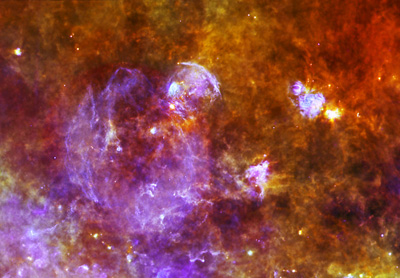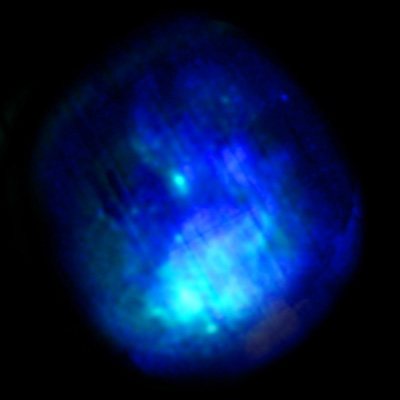

| Visitors Now: | |
| Total Visits: | |
| Total Stories: |

| Story Views | |
| Now: | |
| Last Hour: | |
| Last 24 Hours: | |
| Total: | |
Life And Death In A Star-Forming Cloud

Credits: Herschel: Q. Nguyen Luong & F. Motte, HOBYS Key Program consortium, Herschel SPIRE/PACS/ESA consortia. XMM-Newton: ESA/XMM-Newton
W44, located around 10 000 light-years away within a forest of dense star-forming clouds in the constellation of Aquila, the Eagle, is one of the best examples of a supernova remnant interacting with its parent molecular cloud.
The product of a massive star that has already reached the end of its life and expelled its outer layers in a dramatic explosion, all that remains of the stellar behemoth is the spinning core of a neutron star, or pulsar.
Identified as PSR B1853+01, the pulsar is the bright point to the top left in W44, coloured light blue in this image.
Herschel’s three-colour infrared view of supernova remnant W44 and surrounding regions comprising PACS 70 and 160 micron and SPIRE 250 micron images.

Credits: Herschel: Q. Nguyen Luong & F. Motte, HOBYS Key Program consortium, Herschel SPIRE/PACS/ESA consortia
It is thought to be around 20 000 years old and as it rapidly rotates it sweeps out a wind of highly energetic particles and beams of light ranging from radio to X-ray energies.
The centre of the supernova remnant is also bright in X-rays, coming from the hot gas that fills the shell, at temperatures of several million degrees. Dense knots of high-energy emission reflect regions where heavier elements are more commonly found.
At the cooler edge of the cavity, gas is swept up as the supernova remnant propagates through space.
Supernova remnant W44 revealed by XMM-Newton at high (light blue) and low (dark blue) energy X-ray emission corresponding to energies of 2–8 keV and 1.2-2 keV, respectively. Knots of dense X-ray emission represent locations where the abundance of heavier elements is elevated. Pulsar PSR B1853+01 can be seen as the bright point source coloured light blue towards the top left of W44 in this image. The striping is a result of the image processing.

Credits: ESA/XMM-Newton
At the top right of the expanding shell, there is a smaller cavity, with the shock from the supernova remnant impacting the bight arc-shaped feature. This region is filled with hot gas that has been ionised by the intense ultraviolet radiation from embedded young massive stars.
Herschel’s far-infrared eyes can also seek out regions of gently heated gas and dust further from W44, where new stars are congregating.
Annotated image of W44 and surrounds.

Credits: Herschel: Q. Nguyen Luong & F. Motte, HOBYS Key Program consortium, Herschel SPIRE/PACS/ESA consortia. XMM-Newton: ESA/XMM-Newton
|
|
Examples include the arrowhead-shaped star-formation region to the right of W44, which appears to point to another trio of intricate clouds further to the right and above.
More broadly, a number of compact objects scattered across the scene map the cold seeds of future stars that will eventually emerge from their dusty cocoons.
Finally, diffuse purple emission towards the bottom left of the image provides a glimpse of the Galactic plane.
Contacts and sources:
Markus Bauer
European Space Agency


